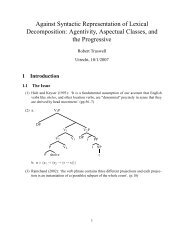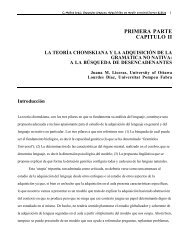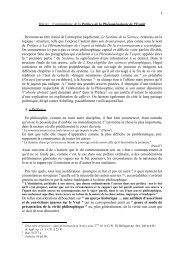Technology and the Canadian Forest-Product Industries ... - ArtSites
Technology and the Canadian Forest-Product Industries ... - ArtSites
Technology and the Canadian Forest-Product Industries ... - ArtSites
You also want an ePaper? Increase the reach of your titles
YUMPU automatically turns print PDFs into web optimized ePapers that Google loves.
countries is conducted in-house testifies to a widespread belief that asignificant proportion of <strong>the</strong> returns on in-house R&D is appropriable<strong>and</strong> is not transferable at negligible social COSP3On <strong>the</strong> o<strong>the</strong>r h<strong>and</strong> cooperative R&D has many drawbacks. Themain one is that it cannot provide firm-specific or in some respectseven nation-specific advantages, which means that cooperative R&Dleads to adaptive <strong>and</strong> dependent technological strategies. It is costly<strong>and</strong> risky to transfer technology: a cooperative R&D lab will not succeedunless firms are equipped to absorb its research results. In <strong>the</strong>United Kingdom <strong>and</strong> <strong>the</strong> United States, association laboratories inmany industries have only achieved mixed success. There are alsolimits to how much <strong>Canadian</strong> forest-product firms are willing to payfor cooperative R&D: Feric, Forintek, <strong>and</strong> in some ways, evenPaprican, still rely on government support. In <strong>the</strong> absence of in-houseR&D, especially in wood harvesting <strong>and</strong> wood processing, <strong>the</strong>re arestrong pressures, particularly on Feric <strong>and</strong> Forintek, to be moredevelopmental <strong>and</strong> concerned with relatively short-term projects.Attitudes toward Government R&D PolicyAll survey respondents in forest-product firms <strong>and</strong> equipment supplierswith in-house R&D programs thought <strong>the</strong> government shouldsupport R&D. Nobody claimed that incentives were crucial to R&D,but <strong>the</strong>y did regard <strong>the</strong>m as useful. All respondents considered taxincentives, including tax credits, to be effective forms of R&D assistance.MacMillan Bloedel has also argued in favour of a cash advanceoption in years when firms have little or no taxable income." Feelingswere mixed regarding government grants: R& D managers withinforest-product firms did not think <strong>the</strong>y were effective; however, amajority of R&D managers within equipment suppliers thoughto<strong>the</strong>rwise.The use of R&D grants available from government agencies hasbeen minimal among forest-product firms with in-house R&D groups,partly because <strong>the</strong> application process takes too much time, <strong>and</strong> partlybecause of concerns about secrecy. Government grants for R&Dare, however, more important to equipment suppliers, although someapplicants have not been pleased with <strong>the</strong>ir experience. One largerfirm had unsuccessfully attempted to obtain four grants from federalgovernment agencies. It argued bitterly that R&D granting programsstrongly favour smaller companies, a bias that it considered to be awaste of time. No doubt this attitude was influenced by <strong>the</strong> fact thattwo of its former employees had received government support when<strong>the</strong>y recently left to form <strong>the</strong>ir own company as a direct competitor.79
















